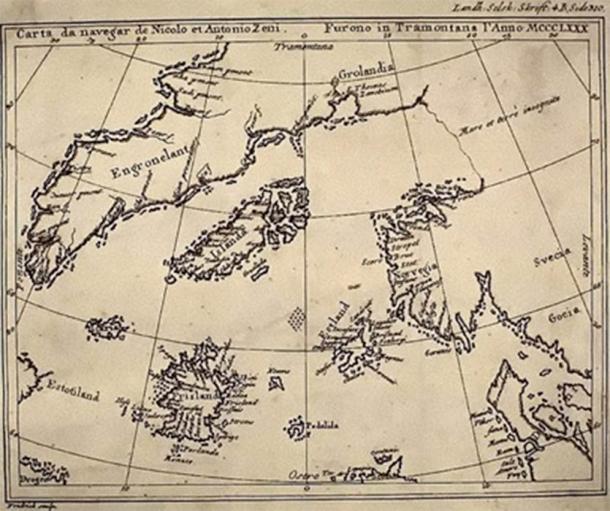
The Zeno Map And Travels Of the 14th-Century Venetian Zeno Brothers
A century before Columbus, at the zenith of Venice's splendour, two brothers, Nicolò and Antonio Zeno embarked an extraordinary journey to the far north following Viking trade routes on the shores of Canada. The travel log of the 14th-century Venetian brothers, which included the now famous Zeno map showing mysterious islands, and made reference to a mysterious benefactor Prince Zichmni, was discarded as a hoax, until recently new investigations. Who were these extraordinary men, what did they discover and why was their story subjected to damnatio memoriae since the 19th century?

A reproduction of the Zeno map from a 1793 book (Public Domain)
The Zeno Map
The Biblioteca Marciana in Venice, in St. Mark's Square, holds a book dated to 1558, Dello Scoprimento dell’Isole Frislanda, Eslanda, Engroneland, Estotiland et Icaria fatto sotto il Polo Artico da due fratelli Zeni, ( About the discovering of the islands of Frisland, Esland, Engroneland, Estotiland et Icaria made under the Arctic Pole by two Zeno brothers) published by Francesco Marcolini. In the introduction he explains that the narrative was written by Nicolò Zeno the Younger, great-nephew of Antonio and Nicolò Zeno, the two navigators whose travels are described in the text. Nicolò Zeno the Younger reports that he found five long letters of his ancestors in the family library and that he was able to proceed with a careful editing of their story, adding parts of the missing text on his own to connect the passages of the letters. With regret he adds that, having found them as a child in the family library and not comprehending their value he had irreparably ruined them so that a considerable part of the information was lost.

Biblioteca Nazionale Marciana (Public Domain)
Venice had become the world capital of publishing in the 16th century and travel logs were always confirmed among the most successful books: Nicolò the Younger wanted to add prestige to his family name by publishing the exploits of his ancestors. He added a nautical map in the style of the time ( carta da navegar) to the text, which came to be known in history as the Zeno Map.
It is a typical map of the 14th-century which clearly distinguishes Norway, Sweden, Greenland and Iceland, as depicted by the respective place names on the map. But what differentiates this map are the mysterious islands that nobody had heard of at the time: Friesland, Icaria, Estotilanda, and even the coasts of the Newfoundland area in today's Canada and parts of the southernmost areas.
Like this Preview and want to read on? You can! JOIN US THERE ( with easy, instant access ) and see what you’re missing!! All Premium articles are available in full, with immediate access.
For the price of a cup of coffee, you get this and all the other great benefits at Ancient Origins Premium. And - each time you support AO Premium, you support independent thought and writing.
Pierluigi Tombetti is a historian, author and writer who has thoroughly investigated the ideological and social reasons and motivations of National Socialism. Writer, columnist and editor in the historical and archaeological field, he is the author of reportages, articles and essays including SYNCHRONICITY - Flight 9941
Top Image: A 19th-century engraving of a Venetian galley fighting a Genoese fleet at the battle of Curzola in 1298. The Granger Collection (Public Domain)















